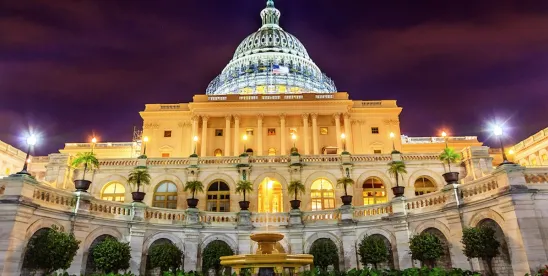The Beltway Buzz is a weekly update summarizing labor and employment news from inside the Beltway and clarifying how what’s happening in Washington, D.C., could impact your business.
Looking Ahead to 2025. The U.S. Congress is back this week for its lame-duck session, but even with a lengthy to-do list, all eyes are on 2025, as the labor, employment, and immigration policy landscapes are already coming into clearer focus after last week’s elections. Here are the latest post-election developments:
- Congressional leadership. This week, Republicans began the process of sorting out their leadership ranks for the 119th Congress. In the U.S. Senate, Republicans elected John Thune of South Dakota to be Senate majority leader in the 119th Congress. It has been eighteen years since anyone other than Mitch McConnell (R-KY) has led Republicans in the Senate. In the U.S. House of Representatives, Mike Johnson (R-LA) will be the Republicans’ nominee for Speaker of the House in a floor vote that will happen in January (you may remember how those votes went last year). Neither Thune nor Johnson has much experience with labor and employment policy, as neither has served on the relevant committees in the Senate or House. However, Senator Bill Cassidy (R-LA) will chair the Senate Committee on Health, Education, Labor and Pensions (HELP) after serving as ranking member in the current Congress. Cassidy is well-versed on the labor and employment issues that are important to the business community.
- Recess appointments. This past weekend, President-elect Trump wrote on social media that he wanted Republican leadership in the Senate to be willing to go along with presidential recess appointments. Normally, the president appoints senior-level officials to federal agencies on the advice and consent of the Senate. An exception to this rule is the Recess Appointments Clause, which allows the president “to fill up all Vacancies that may happen during the Recess of the Senate” without confirmation by the Senate. The rule was designed to ensure the continuity of vital government functions because unlike today, at that time, the Senate would often go months without convening. Presidents since George Washington have used the recess appointment power, though neither Trump nor President Joe Biden have made recess appointments due to the 2014 Noel Canning decision in which a unanimous Supreme Court of the United States held that shorter recess periods of three days are insufficient to permit recess appointments. Trump’s demand, therefore, would not only require Republican senators to abdicate their own constitutional authority, but it would also require the Senate to adjourn for periods of sufficient length (i.e., more than ten days) to satisfy the Noel Canning test. Keep in mind, too, that appointments to the federal agencies and judiciary require only a majority vote, and Republicans are in the majority.
- Immigration nominations. This week, President-elect Trump began announcing his nominees to run certain federal agencies and other policy posts. With immigration and the southern border being major campaign issues for President-elect Trump and his fellow Republicans, it is perhaps no surprise that immigration-related appointments topped his list. Accordingly, this week, the president-elect promised to nominate Senator Marco Rubio (R-FL) as secretary of state and Republican South Dakota Governor Kristi Noem as secretary of homeland security.
Perhaps even more importantly, Trump stated that he would appoint Thomas Homan as his “border czar” and Stephen Miller as his deputy chief of staff. Homan and Miller, who would not need Senate confirmation to work in these positions, served in Trump’s first administration. They will assume an outsized role in developing and implementing immigration policy in the new administration and are expected to take a restrictionist stance regarding both illegal and legal immigration. As the Buzz noted seven years ago, a 2016 story in The Washington Post reported, “Thomas Homan deports people. And he’s really good at it.”
NLRB Case “Flurry” Turning Into Blizzard. The Biden-era National Labor Relations Board NLRB) will not go gentle into that good night. With Chair Lauren McFerran’s term on the Board expiring in a matter of weeks, and her potential reconfirmation vote perhaps hanging in the balance, the Board has issued two decisions that overturn decades of Board precedent to severely restrict employers’ ability to communicate with employees.
- Late last week, the Board ruled that employers could violate the National Labor Relations Act (NLRA) by notifying employees that unionization would restrict their ability to address workplace concerns directly with the employer. The decision overturns a forty-year-old NLRB precedent. Daniel A. Adlong and Zachary V. Zagger have the details.
- In the second case, the Board overturned a 1948 decision that clarified employers’ abilities to hold mandatory employee meetings to discuss the pros and cons of unionization. Prohibiting such meetings has been a priority for NLRB General Counsel Jennifer Abruzzo. The Board majority brushed aside the First Amendment, as well as the provision in the National Labor Relations Act allowing for “[t]he expressing of any views, argument, or opinion,” to rule that these meetings interfere with employees’ rights to engage in protected, concerted activity. Member Marvin Kaplan dissented, writing, “Here, the conflict between the majority’s prohibition of captive-audience speeches and the [First Amendment to the] Constitution is manifest and irreconcilable.” John T. Merrell and Zachary V. Zagger have the details.
Federal Court Strikes Down “Parole in Place” Program. Late last week, the U.S. District Court for the Eastern District of Texas set aside and vacated President Biden’s “parole in place” program that was intended to permit certain noncitizen spouses and stepchildren of U.S. citizens to apply for adjustment of status to lawful permanent resident while remaining in the United States. The court ruled that the Immigration and Nationality Act addresses “parole ‘into the United States,’ not parole ‘in place.’ As shown by statutory text, structure, history, and purpose, that limiting phrase refers to a legal entry into this country.” If the federal government appeals the order, the Trump administration is unlikely to continue to defend the rule.
Reassessing Recess. While President-elect Trump’s insistence on recess appointments is perhaps unusual, the actual practice of a president making recess appointments, as noted above, has been happening since President George Washington. In the last several decades alone, President Ronald Reagan made 240 recess appointments, President George H. W. Bush made 77 recess appointments, President Bill Clinton made 139 recess appointments, President George W. Bush made 171 recess appointments, and President Barack Obama made 32 recess appointments. Presidents have used recess appointments to install nine Supreme Court justices, including three by President Dwight D. Eisenhower: Chief Justice Earl Warren and Associate Justices William J. Brennan and Potter Stewart. (All three were later confirmed by the Senate.)




 />i
/>i

